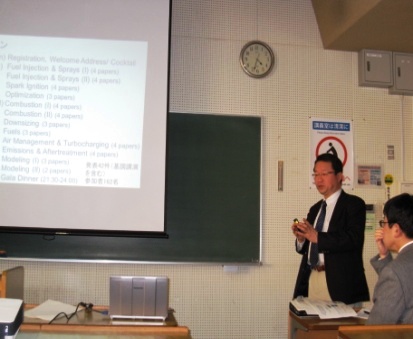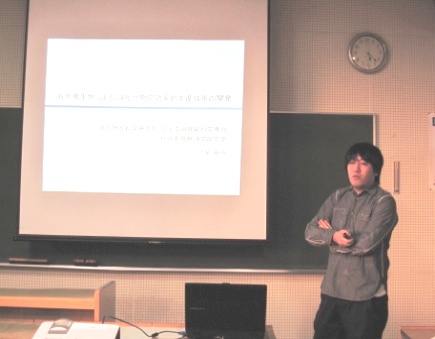|
On Mar 15, 2013, the 7th Biomass Evening Seminar was held at Graduate School of Engineering, Hiroshima University.
Biomass Project Research Center, Hiroshima University, and HOSTY Association are co-organizing the Hiroshima University Biomass Evening Seminar. This seminar covers topics from the fundamentals of biomass to the latest information so that it can contribute the activities on biomass in this district.
Yukihiko MATSUMURA
Professor, Faculty of Engineering
|
|
"Effects of Ultra-High Injection Pressure, Micro-hole Nozzle and Fuel Property on Spray and Combustion Characteristics of Biodiesel Fuel"
Keiya NISHIDA
Professor, Institute of Engineering, Hiroshima University
 An experimental study was made of the effects of ultra-high injection pressure, micro-hole nozzle and fuel property on the spray and combustion characteristics of the Biodiesel fuel (BDF, from a palm oil source). An experimental study was made of the effects of ultra-high injection pressure, micro-hole nozzle and fuel property on the spray and combustion characteristics of the Biodiesel fuel (BDF, from a palm oil source).
Experiments were performed using the spray combustion test rig consisting of a high-pressure and high-temperature vessel to simulate the real engine in-cylinder condition and a common-rail system for fuel injection. The LIF-PIV (Laser Induced Fluorescence - Particulate Image Velocimetry) technique was used to characterize the air entrainment flow into the spray. The OH* chemiluminescence imaging and two color pyrometry were applied to analyze the spray ignition process and soot/temperature distributions in the spray flame, respectively.
BDF has higher viscosity, density and surface tension than a Diesel fuel, resulting in inferior spray characteristics, such as larger spray droplet size, smaller spray angle and less air entrainment. Increasing the injection pressure and decreasing the nozzle hole diameter improve the BDF spray characteristics and produce the less soot and higher temperature BDF spray flame as compared with the Diesel fuel spray flame. The soot reduction of the BDF spray flame is supposedly due to the oxygen content in the fuel, which is highly enhanced under the combination of the ultra-high injection pressure and the micro-hole nozzle, which is realized by the common rail system.
The common rail system for fuel injection is a superior partner for BDF to realize the low emission combustion.
|
“Development of Technology for Efficient C4 Chemical Production by Useful Microorganisms”
Naoya KATAOKA
D3 Student, Graduate School of Advanced Sciences of Matter
 (R)-1,3-BD is a non-natural, optical active alcohol, which has been used as a building block for the production of industrial chemicals including pheromones, fragrances, insecticides, and as a key chiral intermediate for the synthesis of penem and cabapenem β-lactam antibiotics. So far, 1,3-BD has been synthesized as a racemic mixture of (R)- and (S)- forms, mainly from petroleum-based chemicals such as a prochiral precursor, 4-hydroxy-2-butanone (4H2B), or its racemic and enantiometric compound, through either multiple steps of chemical reaction, of biological means including microbial reduction by native strains or genetically-modified strains and lipase-catalyzed non-aqueous reaction. Nevertheless, upon a current shortage of fossil resources and petrochemical supplies, the bio-based production of 1,3-BD, especially with a high optical purity of (R)-1,3-BD, from renewable biomass becomes a more attractive alternative. Since (R)-1,3-BD is non-naturally synthon and a naturally-occurring metabolic pathway for its production has not yet been known, therefore, (R)-1,3-BD production through biotechnological route is strictly relied on a development of a recombinant bacterial strains using genetic engineering and metabolic engineering approaches. (R)-1,3-BD is a non-natural, optical active alcohol, which has been used as a building block for the production of industrial chemicals including pheromones, fragrances, insecticides, and as a key chiral intermediate for the synthesis of penem and cabapenem β-lactam antibiotics. So far, 1,3-BD has been synthesized as a racemic mixture of (R)- and (S)- forms, mainly from petroleum-based chemicals such as a prochiral precursor, 4-hydroxy-2-butanone (4H2B), or its racemic and enantiometric compound, through either multiple steps of chemical reaction, of biological means including microbial reduction by native strains or genetically-modified strains and lipase-catalyzed non-aqueous reaction. Nevertheless, upon a current shortage of fossil resources and petrochemical supplies, the bio-based production of 1,3-BD, especially with a high optical purity of (R)-1,3-BD, from renewable biomass becomes a more attractive alternative. Since (R)-1,3-BD is non-naturally synthon and a naturally-occurring metabolic pathway for its production has not yet been known, therefore, (R)-1,3-BD production through biotechnological route is strictly relied on a development of a recombinant bacterial strains using genetic engineering and metabolic engineering approaches.
In this study, an effective synthetic biological production route of 1,3-BD from glucose was successfully constructed, which consists of phaA (encoding 3-ketothiolase), phaB (encoding NADPH-dependent acetoacetyl-CoA reductase) from Ralstonia eutropha NBRC 102504 and bld (encoding butylraldehyde dehydrogenase) from Clostridium saccharoperbutylacetonicum ATCC 27012, and expressed in Escherichia coli MG1655 lacIq. With the optimized fermentation conditions, this recombinant whole-cell biocatalyst could produce 1,3-BD up to 9.05 g/L (100.4 mM) with 98.5% enantiomeric excess (%ee) of (R)-1,3-BD.
|

 Home
Home An experimental study was made of the effects of ultra-high injection pressure, micro-hole nozzle and fuel property on the spray and combustion characteristics of the Biodiesel fuel (BDF, from a palm oil source).
An experimental study was made of the effects of ultra-high injection pressure, micro-hole nozzle and fuel property on the spray and combustion characteristics of the Biodiesel fuel (BDF, from a palm oil source). (R)-1,3-BD is a non-natural, optical active alcohol, which has been used as a building block for the production of industrial chemicals including pheromones, fragrances, insecticides, and as a key chiral intermediate for the synthesis of penem and cabapenem β-lactam antibiotics. So far, 1,3-BD has been synthesized as a racemic mixture of (R)- and (S)- forms, mainly from petroleum-based chemicals such as a prochiral precursor, 4-hydroxy-2-butanone (4H2B), or its racemic and enantiometric compound, through either multiple steps of chemical reaction, of biological means including microbial reduction by native strains or genetically-modified strains and lipase-catalyzed non-aqueous reaction. Nevertheless, upon a current shortage of fossil resources and petrochemical supplies, the bio-based production of 1,3-BD, especially with a high optical purity of (R)-1,3-BD, from renewable biomass becomes a more attractive alternative. Since (R)-1,3-BD is non-naturally synthon and a naturally-occurring metabolic pathway for its production has not yet been known, therefore, (R)-1,3-BD production through biotechnological route is strictly relied on a development of a recombinant bacterial strains using genetic engineering and metabolic engineering approaches.
(R)-1,3-BD is a non-natural, optical active alcohol, which has been used as a building block for the production of industrial chemicals including pheromones, fragrances, insecticides, and as a key chiral intermediate for the synthesis of penem and cabapenem β-lactam antibiotics. So far, 1,3-BD has been synthesized as a racemic mixture of (R)- and (S)- forms, mainly from petroleum-based chemicals such as a prochiral precursor, 4-hydroxy-2-butanone (4H2B), or its racemic and enantiometric compound, through either multiple steps of chemical reaction, of biological means including microbial reduction by native strains or genetically-modified strains and lipase-catalyzed non-aqueous reaction. Nevertheless, upon a current shortage of fossil resources and petrochemical supplies, the bio-based production of 1,3-BD, especially with a high optical purity of (R)-1,3-BD, from renewable biomass becomes a more attractive alternative. Since (R)-1,3-BD is non-naturally synthon and a naturally-occurring metabolic pathway for its production has not yet been known, therefore, (R)-1,3-BD production through biotechnological route is strictly relied on a development of a recombinant bacterial strains using genetic engineering and metabolic engineering approaches.